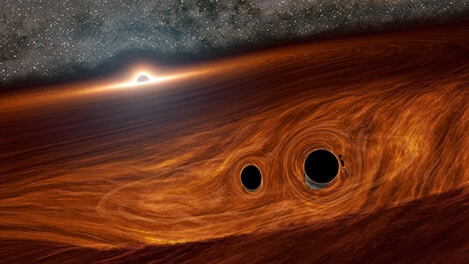A possible burst of light has been observed from small black holes within the disk surrounding a supermassive black hole

When two black holes move in a mutual spiral orbit and eventually collide, they send out ripples in space and time called gravitational waves. Because blackheads do not emit light, these events are not expected to glow with any light waves, or electromagnetic radiation. The astrophysicists K. A. Saavik Ford and Barry McKernan of CUNY's Center for Graduate Studies presented ways in which merging black holes might explode with light. Now, for the first time, astronomers have seen evidence of one of these light-producing scenarios. Their findings are available in the current issue of Physical Review Letters.
A team including scientists from CUNY's Center for Graduate Studies, Caltech's Zwicky Transient Facility (ZTF), Borough of Manhattan Community College (BMCC) and the American Museum of Natural History (AMNH) has discovered what appears to be a burst of light from a pair of merging black holes. The event (called S190521g) was first detected by the National Science Foundation's (NSF) Laser Interferometer Gravitational Wave Observatory (LIGO) and the European Vigo detector on May 21, 2019. As the black holes merged, shaking up space and time, they sent out gravitational waves. Soon after, scientists at the ZTF—located at the Plummer Observatory near San Diego—reviewed their recordings of the same event and discovered what could be a burst of light coming from the merging black holes.
"At the center of most galaxies is a supermassive black hole. It is surrounded by a swarm of stars and dead stars, including black holes," said study co-author Ford, a professor at the Center for Advanced Studies, BMCC and AMNH. “These objects move like a swarm of nervous bees around the monstrous queen mother in the center. They can briefly find gravity partners and mate with them but usually lose their partner quickly to the crazy dance. But in the disc of a supermassive black hole, the flowing gas turns the swarm's wild dance zone into a classical minuet, organizing the black holes so they can pair up," she says.
Once the black holes merge, the new, now larger black hole experiences a kick that sends it in a random direction, and it passes through the gas in the disc. "It is the reaction of the gas to this fast projectile that creates a bright burst, visible through a telescope," said co-author McCarnan, a professor of astrophysics at the Center for Graduate Studies, BMCC and AMNH.
"This supermassive black hole had been bubbling for years before this more sudden outburst," said lead study author Matthew Graham, research professor of astronomy at Caltech and ZTF project scientist. "The eruption occurred at the right time and place, and at the same time as the gravity wave event. In our research, we conclude that the outburst is probably the result of a merger between black holes, but we cannot completely rule out other possibilities."
"ZTF was designed specifically to detect new, rare, and different types of astronomical activity like this," said NSF Astronomical Sciences Division Director Ralph Gomm. "NSF's support of new technologies continues to expand our ways of discovering such events."
Such an eruption is expected to begin days to weeks after the first splash of gravitational waves created during the merger. In this case, ZTF didn't capture the event right away, but when the scientists went back and looked at images from the ZTF archive months later, they found a signal that started days after the May 2019 gravitational wave event. ZTF watched the outburst slowly fade over a period of a month.
The scientists were trying to get a more detailed look at the supermassive black hole's light, called a spectrum, but by the time they looked, the outburst had already faded. A spectrum would have provided further support for the idea that the outburst came from merging black holes within the disk of the supermassive black hole. But the researchers say they have been able to rule out most other possible causes for the observed outburst, including a supernova or a tidal rip event, which occurs when a black hole actually eats a star.
In addition, the team says it is unlikely that the outburst came from the normal noises of the supermassive black hole, which regularly feed the disk that surrounds it. Using the Catalina Real-Time Transient Survey, run by Caltech, they were able to assess the behavior of the black hole over the past 15 years, and found that its activity was relatively normal until May 2019 when it suddenly increased.
“Supermassive black holes like this have outbursts all the time. They are not quiescent objects, but the timing, size and location of this outburst was spectacular," said co-author Mancy Castlewal, senior lecturer in astronomy at Caltech. "The reason that looking for such bursts is so important is that it helps a lot with questions of astrophysics and cosmology. If we can do this again and detect light from other black hole mergers, then we can locate the home of these black holes and know more about their origin."
The newly formed black hole will cause another eruption in the coming years. The merger process gave the object a kick that would cause it to re-enter the disk of the supermassive black hole, creating another burst of light that could be seen in the ZTF.
More of the topic in Hayadan:

One response
The two fundamental concepts in the Newtonian universe are force and matter
The two fundamental concepts in the Einsteinian universe are energy and matter
The two fundamental concepts in the neural universe are energy and passive time
http://img2.timg.co.il/forums/2/7512af65-e1e5-47ac-af36-b3654d2d790b.pdf